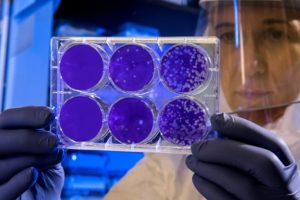17 Dec 2021 The Top 10 Most Common Pathogens Causing Foodborne Illness
Advancements in Food Safety and technology have played a significant role in reducing the frequency and severity of Foodborne Illness in the UK and developed world. Despite this, outbreaks can and do still happen.
The Food Standards Agency (FSA) estimates 2.4million cases of Foodborne Illness occur in the UK, resulting in 180 deaths per year.
Even if your business has excellent food safety and hygiene practices, there’s always a risk of a mistake or oversight.
There are currently 31 recognised Foodborne pathogens including bacteria, viruses, parasites, toxins and chemicals that can cause food and water contamination.
Here we explore the top 10 culprits, their common sources, effects, and how to avoid them:
1. Campylobacter
Pathogen:
Bacteria
Sources:
Undercooked poultry, meat, raw milk, shellfish or contaminated products.
Effects:
Campylobacteriosis causes diarrhoea, abdominal pain, fever, headache, nausea and/or vomiting. Symptoms usually occur 2 to 5 days after infection, last for 3 to 6 days and are usually mild but can be fatal in rare cases.
Prevention:
Biosecurity measures on the farm, hygienic slaughter procedures, hygienic raw meat handling and cross-contamination prevention help stop the spread of infection. Cook meat to a minimum temperature of 70°C.
2. Clostridium Botulinum
Pathogen:
Bacteria
Sources:
Improper canning or preserving of foods. Honey.
Effects:
Botulism is a rare but serious disease. Toxins produced by the bacteria can cause neurological illness. Symptoms include paralysis and breathing difficulties.
Prevention:
Carefully follow food hygiene procedures and canning recommendations, treating canned foods at high temperatures to kill botulism spores. Avoid tinned foods where the tin is bulging or damaged. Do not feed honey to infants under 12 months.
3. Clostridium Perfringens
Pathogen:
Bacteria
Sources:
Meat, poultry, gravies and other foods cooked in large quantities like stews and soups.
Effects:
Diarrhoea and stomach cramps. Onset is usually within 6 to 24 hours of infection, begins suddenly and lasts for under 24 hours. Usually mild.
Prevention:
Cook food to the relevant minimum safe cooking temperature. Cool food rapidly if not eating immediately and store in the refrigerator at 5°C or below.
4. Cyclospora Cayetanensis
Pathogen:
Parasite
Sources:
Raw fruit and vegetables or water contaminated with human faeces.
Effects:
Cyclospora is a parasite found in many developing countries, but infections can be brought back to the UK. Symptoms include weight loss, fatigue, nausea, bloating, stomach cramps and loss of appetite.
Prevention:
Wash your hands with soap and water after going to the toilet and before preparing or eating food. Ensure food is piping hot. Wash fruit and vegetables in clean water.
5. E. Coli
Pathogen:
Bacteria
Sources:
Raw or undercooked ground meat products, raw milk or contaminated vegetables.
Effects:
Symptoms include abdominal cramps, diarrhoea, fever and vomiting. The onset of symptoms is usually within 3 to 8 days of infection and recovery happens within 10 days.
Prevention:
Cook all meat products to minimum temperatures and ensure cooked vegetables are piping hot. Wash all vegetables and salad leaves unless labelled “ready to eat”. Thorough handwashing. Do not allow anyone who has been infected to prepare food for at least 48 hours after symptoms ended.
6. Listeria Monocytogenes
Pathogen:
Bacteria
Sources:
Unpasteurised milk, dairy products made from unpasteurised milk like soft cheeses, chilled ready-to-eat foods like deli meats, pâté and prepackaged sandwiches.
Effects:
Listeriosis can occur without symptoms but be transmitted to others. Symptomatic people may have a high temperature, body aches, chills, nausea and/or vomiting and diarrhoea. Symptoms occur between 1 and 90 days from exposure. Usually self-limiting but can cause complications for pregnant women or immunocompromised individuals.
Prevention:
Thorough handwashing techniques. Wash fruit and vegetables before eating. Cook all food to relevant minimum temperatures. Dispose of food past its use-by-date. Refrigeration is ineffective against preventing listeria outbreaks.
7. Norovirus
Pathogen:
Virus
Sources:
Undercooked or raw shellfish. Any food contaminated by an infected individual. Leafy greens like salad leaves, fresh fruit and ready-to-eat foods.
Effects:
Symptoms include diarrhoea, vomiting, nausea and stomach pain, fever, headache and body aches. Onset is usually 12 – 48 hours after exposure and symptoms last between 1 and 3 days.
Prevention:
Carefully wash fruits and vegetables before preparing and/or eating. Cook oysters and other shellfish thoroughly. Norovirus can survive for weeks on hard surfaces, and survive temperatures up to 65°C. Do not allow infected people to handle food for at least 48 hours after symptoms have subsided.
8. Salmonella
Pathogen:
Bacteria
Sources:
Raw unpasteurised milk, undercooked or raw eggs, raw or undercooked meats, particularly poultry, contaminated fruits and vegetables.
Effects:
Diarrhoea, abdominal pain, fever, headache, nausea and/or vomiting and fatigue. The onset of symptom is usually within 12 hours to 3 days and last between 3 and 7 days for most. Some cases may take weeks or months to fully recover, and it is occasionally fatal.
Prevention:
Thorough handwashing and hygiene procedures. Avoid cross-contamination through kitchen utensils like chopping boards and knives. Cook meat to the required temperature, store cooked and uncooked foods separately. If food isn’t eaten immediately, cool rapidly then place in fridge or freezer. Reheat foods thoroughly and wash all salad vegetables and fruit.
9. Staphylococcus Aureus
Pathogen:
Bacteria
Sources:
Any foods handled by an infected person. Ready to eat foods like baked goods, deli meats, cheese and dairy products, pre-made sandwiches and buffets.
Effects:
Toxins produced by staph cause the illness. Symptoms come on quickly, within 30 minutes to 6 hours, and include nausea, vomiting, stomach cramps and diarrhoea. Symptoms last around 1 day.
Prevention:
Many people carry staphylococcus without infection and can contaminate food with unclean hands. Don’t allow anyone with a nose, eye, skin or wound infection to handle food. Thorough handwashing is critical. Keep food preparation areas clean. Keep hot foods hot and cold foods cold. Rapidly cool cooked food and refrigerate below 5°C.
10. Vibrio Vulinficus
Pathogen:
Bacteria
Sources:
Raw or undercooked seafood and shellfish.
Effects:
Vibriosis causes diarrhoea, abdominal cramps, nausea, vomiting, fever and chills. The onset of symptoms is usually within 24 hours of ingestion and last around 3 days.
Prevention:
Thorough handwashing after handling raw shellfish and seafood. Ensure seafood is thoroughly cooked. Store cooked and raw foods separately.
The importance of Food Safety training in preventing Foodborne illness
The potential consequences of causing Foodborne illness are deadly. Ensuring everyone in your business is fully informed on how to make sure the food you sell is safe to eat is paramount.
Sign up for Food Safety training today.











